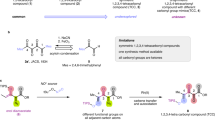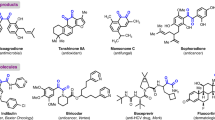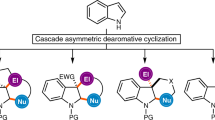Abstract
The synthesis of 1,4-dicarbonyls is a considerable challenge to organic chemists. While classical strategies to form 1,n-dioxygenated fragments, in which n is an odd number, are based on natural polarity, such that synthetic approaches are intuitive, the synthesis of 1,4-dicarbonyl moieties is more challenging and therefore less easily conceptualized. Owing to the intrinsic mismatch of the carbonyl polarity, 1,4-dicarbonyl compounds are a welcome retrosynthetic challenge to the creativity of synthetic chemists. Over the past decades, this problem has been addressed by multiple methods, which include organocatalytic Stetter reactions, oxidative enolate coupling and Claisen rearrangement–cleavage cascades, which all show remarkable levels of stereocontrol. Recent advances in forming 1,4-dicarbonyls largely focused on radical Stetter-type approaches or enolate umpolung reactions employing enolonium intermediates, as well as other methodologies that use non-carbonyl precursors. These routes give rise to the array of procedures presented in this Review. The Review also provides examples from natural product synthesis, which show that—despite the considerable advances in the field—there is still no singular, broadly applicable solution to the challenge of 1,4-dicarbonyl synthesis.

This is a preview of subscription content, access via your institution
Access options
Subscribe to this journal
Receive 12 digital issues and online access to articles
$119.00 per year
only $9.92 per issue
Buy this article
- Purchase on Springer Link
- Instant access to full article PDF
Prices may be subject to local taxes which are calculated during checkout








Similar content being viewed by others
References
Fujisawa, T. et al. Highly water-soluble matrix metalloproteinases inhibitors and their effects in a rat adjuvant-induced arthritis model. Bioorg. Med. Chem. 10, 2569–2581 (2002).
Polonsky, J. in Progress in the Chemistry of Organic Natural Products (eds Cormier, M. J. et al.) 101–150 (Springer, 1973).
Tokiwa, Y., Calabia, B. P., Ugwu, C. U. & Aiba, S. Biodegradability of plastics. Int. J. Mol. Sci. 10, 3722–3742 (2009).
Corey, E. J. & Seebach, D. Synthesis of 1,n-dicarbonyl derivates using carbanions from 1,3-dithianes. Angew. Chem. Int. Ed. 4, 1077–1078 (1965).
Seebach, D. Methods of reactivity umpolung. Angew. Chem. Int. Ed. 18, 239–258 (1979).
Stetter, H. & Schreckenberg, M. A new method for addition of aldehydes to activated double bonds. Angew. Chem. Int. Ed. 12, 81–81 (1973).
Yetra, S. R., Patra, A. & Biju, A. T. Recent advances in the N-heterocyclic carbene (NHC)-organocatalyzed Stetter reaction and related chemistry. Synthesis 47, 1357–1378 (2015).
Heravi, M. M., Zadsirjan, V., Kafshdarzadeh, K. & Amiri, Z. Recent advances in Stetter reaction and related chemistry: an update. Asian J. Org. Chem. 9, 1999–2034 (2020).
Stetter, H. Catalyzed addition of aldehydes to activated double bonds-a new synthetic approach. Angew. Chem. Int. Ed. 15, 639–647 (1976).
Enders, D., Breuer, K., Runsink, J. & Teles, J. H. The Frist asymmetric intramolecular Stetter reaction. Preliminary communication. Helv. Chim. Acta 79, 1899–1902 (1996).
Sohn, S. S., Rosen, E. L. & Bode, J. W. N-heterocyclic carbene-catalyzed generation of homoenolates: γ-butyrolactones by direct annulations of enals and aldehydes. J. Am. Chem. Soc. 126, 14370–14371 (2004).
Glorius, F. & Burstein, C. Conjugate umpolung of a,β-unsaturated aldehydes for the synthesis of γ-butyrolactones. Angew. Chem. Int. Ed. 43, 6205–6208 (2004).
de Alaniz, J. R., Kerr, M. S., Moore, J. L. & Rovis, T. Scope of the asymmetric intramolecular Stetter reaction catalyzed by chiral nucleophilic triazolinylidene carbenes. J. Org. Chem. 6, 2033–2040 (2008).
Barik, S. et al. NHC-catalyzed desymmetrization of N-aryl maleimides leading to the atroposelective synthesis of N-aryl succinimides. Angew. Chem. Int. Ed. 60, 12264–12268 (2021).
Garapati, V. K. R. & Gravel, M. Oxazolium salts as organocatalysts for the umpolung of aldehydes. Org. Lett. 20, 6372–6375 (2018).
Yadav, S. & Suresh, S. N‐heterocyclic carbene (NHC)‐catalyzed intramolecular Stetter reaction to access dibenzo‐fused seven‐membered heterocycles. Asian J. Org. Chem. 10, 1406–1409 (2021).
Rezazadeh Khalkhali, M., Wilde, M. M. D. & Gravel, M. Enantioselective Stetter reactions catalyzed by bis(amino)cyclopropenylidenes: important role for water as an additive. Org. Lett. 23, 155–159 (2021).
Dzieszkowski, K. & Rafiński, Z. N‐heterocyclic carbene‐catalyzed enantioselective intramolecular annulations to construct benzo‐fused pyranones with quaternary stereocenter. Adv. Synth. Catal. 362, 3830–3835 (2020).
Chen, X. et al. Intramolecular stereoselective Stetter reaction catalyzed by benzaldehyde lyase. Angew. Chem. Int. Ed. 60, 9326–9329 (2021).
Yoo, E. J., Wasa, M. & Yu, J.-Q. Pd(II)-catalyzed carbonylation of C(sp3)-H bonds: a new entry to 1,4-dicarbonyl compounds. J. Am. Chem. Soc. 132, 17378–17380 (2010).
Ji, X., Shen, C., Tian, X. & Dong, K. Palladium-catalyzed asymmetric hydroesterification of α-aryl acrylic acids to chiral substituted succinates. Org. Lett. 23, 8645–8649 (2021).
Giese, B. & Lachhein, S. Steric effects in the addition of alkyl radicals to alkenes. Angew. Chem. Int. Ed. 20, 967–967 (1981).
Morack, T., Mück-Lichtenfeld, C. & Gilmour, R. Bioinspired radical Stetter reaction: radical umpolung enabled by ion-pair photocatalysis. Angew. Chem. Int. Ed. 58, 1208–1212 (2019).
Zhao, J.-J., Zhang, H.-H., Shen, X. & Yu, S. Enantioselective radical hydroacylation of enals with α-ketoacids enabled by photoredox/amine cocatalysis. Org. Lett. 21, 913–916 (2019).
Goti, G., Bieszczad, B., Vega-Peñaloza, A. & Melchiorre, P. Stereocontrolled synthesis of 1,4-dicarbonyl compounds by photochemical organocatalytic acyl radical addition to enals. Angew. Chem. Int. Ed. 58, 1213–1217 (2019).
Cheng, Y.-Y. et al. Direct 1,2-dicarbonylation of alkenes towards 1,4-diketones via photocatalysis. Angew. Chem. Int. Ed. 60, 26822–26828 (2021).
Hervieu, C. et al. Asymmetric, visible light-mediated radical sulfinyl-Smiles rearrangement to access all-carbon quaternary stereocentres. Nat. Chem. 13, 327–334 (2021).
Che, C., Qian, Z., Wu, M., Zhao, Y. & Zhu, G. Intermolecular oxidative radical addition to aromatic aldehydes: direct access to 1,4- and 1,5-diketones via silver-catalyzed ring-opening acylation of cyclopropanols and cyclobutanols. J. Org. Chem. 83, 5665–5673 (2018).
Starkey, L. S. Introduction to Strategies for Organic Synthesis (John Wiley & Sons, 2018).
Arava, S. et al. Enolonium species—umpoled enolates. Angew. Chem. Int. Ed. 56, 2599–2603 (2017).
Parida, K. N., Pathe, G. K., Maksymenko, S. & Szpilman, A. M. Cross-coupling of dissimilar ketone enolates via enolonium species to afford non-symmetrical 1,4-diketones. Beilstein J. Org. Chem. 14, 992–997 (2018).
Kaiser, D., Bauer, A., Lemmerer, M. & Maulide, N. Amide activation: an emerging tool for chemoselective synthesis. Chem. Soc. Rev. 47, 7899–7925 (2018).
Kaiser, D., Teskey, C. J., Adler, P. & Maulide, N. Chemoselective intermolecular cross-enolate-type coupling of amides. J. Am. Chem. Soc. 139, 16040–16043 (2017).
DeMartino, M. P., Chen, K. & Baran, P. S. Intermolecular enolate heterocoupling: scope, mechanism, and application. J. Am. Chem. Soc. 130, 11546–11560 (2008).
Amaya, T., Maegawa, Y., Masuda, T., Osafune, Y. & Hirao, T. Selective intermolecular oxidative cross-coupling of enolates. J. Am. Chem. Soc. 137, 10072–10075 (2015).
Robinson, E. E. & Thomson, R. J. A strategy for the convergent and stereoselective assembly of polycyclic molecules. J. Am. Chem. Soc. 140, 1956–1965 (2018).
Clift, M. D., Taylor, C. N. & Thomson, R. J. Oxidative carbon–carbon bond formation via silyl bis-enol ethers: controlled cross-coupling for the synthesis of quaternary centers. Org. Lett. 9, 4667–4669 (2007).
Strehl, J. & Hilt, G. Electrochemical, manganese-assisted carbon–carbon bond formation between β-keto esters and silyl enol ethers. Org. Lett. 21, 5259–5263 (2019).
Cuccu, F. et al. Tandem Wittig reaction—ring contraction of cyclobutanes: a route to functionalized cyclopropanecarbaldehydes. Org. Lett. 21, 7755–7758 (2019).
Zhang, H. et al. Visible-light-mediated formal carbene insertion reaction: enantioselective synthesis of 1,4-dicarbonyl compounds containing all-carbon quaternary stereocenter. ACS Catal. 9, 5510–5516 (2022).
Neuhaus, J. D., Bauer, A., Pinto, A. & Maulide, N. A catalytic cross-olefination of diazo compounds with sulfoxonium ylides. Angew. Chem. Int. Ed. 57, 16215–16218 (2018).
Hansen, J. H. et al. Rhodium(II)-catalyzed cross-coupling of diazo compounds. Angew. Chem. Int. Ed. 50, 2544–2548 (2011).
Carman, L., Kwart, L. D. & Hudlicky, T. Claisen/ozonolysis alternative to alkylation of enolate anions. Synthesis of 1,4-dicarbonyl compounds. Synth. Commun. 16, 169–182 (1986).
Bao, R., Valverde, S. & Herradón, B. The Claisen–Johnson rearrangement route to 1,4-dicarbonyl compounds: synthesis of ethyl 4-ethoxy-4-alkenoates as masked 4-oxo esters. Synlett 1992, 217–219 (2002).
Evans, D. A., Bartroli, J. & Shih, T. L. Enantioselective aldol condensations. 2. Erythro-selective chiral aldol condensations via boron enolates. J. Am. Chem. Soc. 103, 2127–2129 (1981).
Kaldre, D., Klose, I. & Maulide, N. Stereodivergent synthesis of 1,4-dicarbonyls by traceless charge-accelerated sulfonium rearrangement. Science 361, 664–667 (2018).
Evano, G., Lecomte, M., Thilmany, P. & Theunissen, C. Keteniminium ions: unique and versatile reactive intermediates for chemical synthesis. Synthesis 49, 3183–3214 (2017).
Huang, X., Klimczyk, S. & Maulide, N. Charge-accelerated sulfonium [3,3]-sigmatropic rearrangements. Synthesis 2012, 175–183 (2012).
Luparia, M. et al. Catalytic asymmetric diastereodivergent deracemization. Angew. Chem. Int. Ed. 50, 12631–12635 (2011). A definition of diastereodivergence in catalysis.
Krautwald, S., Sarlah, D., Schafroth, M. A. & Carreira, E. M. Enantio- and diastereodivergent dual catalysis: α-allylation of branched aldehydes. Science 340, 1065–1068 (2013).
Audisio, D., Luparia, M., Oliveira, M. T., Klütt, D. & Maulide, N. Diastereodivergent de-epimerization in catalytic asymmetric allylic alkylation. Angew. Chem. Int. Ed. 51, 7314–7317 (2012).
Oliveira, M. T., Luparia, M., Audisio, D. & Maulide, N. Dual catalysis becomes diastereodivergent. Angew. Chem. Int. Ed. 52, 13149–13152 (2013).
Beletskaya, I. P., Nájera, C. & Yus, M. Stereodivergent catalysis. Chem. Rev. 118, 5080–5200 (2018).
Zuo, Z. et al. Enantioselective decarboxylative arylation of α-amino acids via the merger of photoredox and nickel catalysis. J. Am. Chem. Soc. 138, 1832–1835 (2016).
Tian, X. et al. Diastereodivergent asymmetric sulfa-Michael additions of α-branched enones using a single chiral organic catalyst. J. Am. Chem. Soc. 133, 17934–17941 (2011).
Huang, Y., Walji, A. M., Larsen, C. H. & MacMillan, D. W. C. Enantioselective organo-cascade catalysis. J. Am. Chem. Soc. 127, 15051–15053 (2005).
Shi, S.-L., Wong, Z. L. & Buchwald, S. L. Copper-catalysed enantioselective stereodivergent synthesis of amino alcohols. Nature 532, 353–356 (2016).
Zhou, W. & Voituriez, A. Gold(I)-catalyzed synthesis of highly substituted 1,4-dicarbonyl derivatives via sulfonium [3,3]-sigmatropic rearrangement. Org. Lett. 23, 247–252 (2021).
Zhou, W. & Voituriez, A. Synthesis of cyclopentenones with C4-quaternary stereocenters via stereospecific [3,3]-sigmatropic rearrangement and applications in total synthesis of sesquiterpenoids. J. Am. Chem. Soc. 143, 17348–17353 (2021).
Kobatake, T., Yoshida, S., Yorimitsu, H. & Oshima, K. Reaction of 2-(2,2,2-trifluoroethylidene)-1,3-dithiane 1-oxide with ketones under Pummerer conditions and its application to the synthesis of 3-trifluoromethyl-substituted five-membered heteroarenes. Angew. Chem. Int. Ed. 49, 2340–2343 (2010).
Huang, S., Kötzner, L., De, C. K. & List, B. Catalytic asymmetric dearomatizing redox cross coupling of ketones with aryl hydrazines giving 1,4-diketones. J. Am. Chem. Soc. 137, 3446–3449 (2015).
Jadhav, A. M., Gawade, S. A., Vasu, D., Dateer, R. B. & Liu, R. S. ZnII- and AuI-catalyzed regioselective hydrative oxidations of 3-en-1-ynes with Selectfluor: realization of 1,4-dioxo and 1,4-oxohydroxy functionalizations. Chem. Eur. J. 20, 1813–1817 (2014).
Dong, Y., Li, R., Zhou, J. & Sun, Z. Synthesis of unsymmetrical 1,4-dicarbonyl compounds by photocatalytic oxidative radical additions. Org. Lett. 23, 6387–6390 (2021).
Shirley, H. J., Koyioni, M., Muncan, F. & Donohoe, T. J. Synthesis of lamellarin alkaloids using orthoester-masked α-keto acids. Chem. Sci. 10, 4334–4338 (2019).
Valot, G. et al. Total synthesis of amphidinolide F. Angew. Chem. Int. Ed. 52, 9534–9538 (2013).
Cernijenko, A., Risgaard, R. & Baran, P. S. 11-step total synthesis of (–)-maoecrystal V. J. Am. Chem. Soc. 138, 9425–9428 (2016).
Cox, J. B., Kimishima, A. & Wood, J. L. Total synthesis of herquline B and C. J. Am. Chem. Soc. 141, 25–28 (2019).
He, C., Stratton, T. P. & Baran, P. S. Concise total synthesis of herqulines B and C. J. Am. Chem. Soc. 141, 29–32 (2019).
Zhu, X., McAtee, C. C. & Schindler, C. S. Total syntheses of herqulines B and C. J. Am. Chem. Soc. 141, 3409–3413 (2019).
Cochrane, J. R., White, J. M., Wille, U. & Hutton, C. A. Total synthesis of mycocyclosin. Org. Lett. 14, 2402–2405 (2012).
Acknowledgements
Generous support by the ERC (CoG VINCAT 682002 to N.M.) is acknowledged. We are also grateful to the University of Vienna and the Center for Molecular Medicine (CeMM) of the Austrian Academy of Sciences for continued support of our research programmes.
Author information
Authors and Affiliations
Contributions
M.L., M.S., D.K. and N.M. contributed to the discussions and wrote the manuscript.
Corresponding author
Ethics declarations
Competing interests
The authors declare no competing interests.
Peer review
Peer review information
Nature Synthesis thanks the anonymous reviewers for their contribution to the peer review of this work. Primary Handling Editor: Alison Stoddart, in collaboration with the Nature Synthesis team.
Additional information
Publisher’s note Springer Nature remains neutral with regard to jurisdictional claims in published maps and institutional affiliations.
Rights and permissions
Springer Nature or its licensor holds exclusive rights to this article under a publishing agreement with the author(s) or other rightsholder(s); author self-archiving of the accepted manuscript version of this article is solely governed by the terms of such publishing agreement and applicable law.
About this article
Cite this article
Lemmerer, M., Schupp, M., Kaiser, D. et al. Synthetic approaches to 1,4-dicarbonyl compounds. Nat. Synth 1, 923–935 (2022). https://doi.org/10.1038/s44160-022-00179-1
Received:
Accepted:
Published:
Issue Date:
DOI: https://doi.org/10.1038/s44160-022-00179-1



